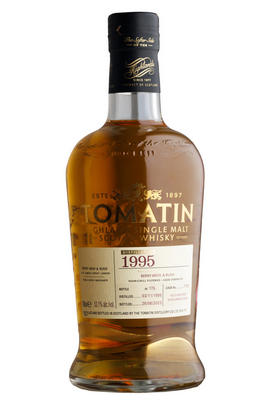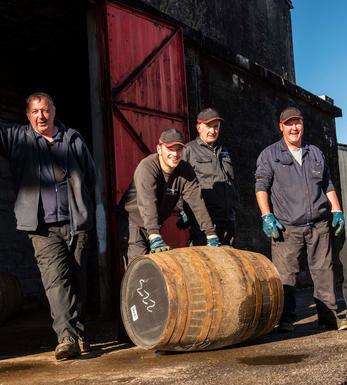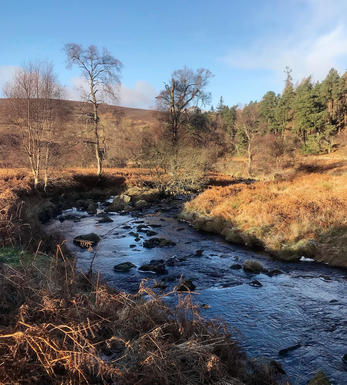
1995 Tomatin, Berry Bros. & Rudd Exclusive, Cask Ref. 7750, Highland, Single Malt Scotch Whisky (53.1%)

About this SPIRIT

Tomatin Distillery
Tomatin Distillery (pronounced Tom-at-in) means `Hill of the Juniper' in the Gaelic language. As a distilling site, illicit or otherwise, Tomatin goes back to the 15th Century when drovers - men who `drove' their cattle to market over high mountain passes - would fill up their whisky flasks from a still alongside the Old Laird's House. It was built on the site in 1897 by the Tomatin Spey District Distillery Co.
Its heydays were from 1950s to 1974 that witnessed a steep increase in its production to almost 12 million litres a year, which made Tomatin the largest Scotch whisky distillery in the world in terms of capacity at the time.
The distillery was acquired by a Japanese venture in 1986, that established the current Tomatin Distillery Company Limited, and launched the modern era of whisky distilling in the Monadhliath Mountains.
The whisky is subtle and quite flavoursome. Stylistically it sits mid-way between light, Highland single malts and other richer, lushier Speyside malts.

Highlands Whisky
Maybe because it is the largest geographical area, the Highlands is also the hardest Whisky region to pin down stylistically. For this reason it is easiest not to consider the Highlands as one large are, but as 4 smaller and much more distinct ones.
North-Highland malts tend to be light bodied, delicate whiskies with complex aromas and a dryish finish sometimes spicy, sometimes with a trace of salt. Northern Highland distilleries are almost all coastal. The most northerly is Old Pulteney, situated about as far north as you can go in Wick, which produces a delicious, fragrant, dry whisky.
Working south along the route of the A9, next comes Clynelish at Brora (built in 1969, beside an earlier distillery who’s whiskies are known as Brora) - a sophisticated and complex whisky older expressions are very highly regarded and the malt deserves to be better known. Perhaps the reason that it is rarely seen as a distillery bottling is that it’s malt is a key component of Johnnie Walker.
The best known of all the Northern Highland malts is Glenmorangie. Glenmorangie, is made at Tain on the Cromarty Firth, and is the most popular malt in Scotland. Over the last decade Glenmorangie pioneered the now often copied process of wood finishing. Althoght this process is not universally popular; it transformed the company’s commercial success.
The Eastern Highlands produce a number of whiskies that can be confused with those of Speyside. In the north of the region close to the southern border of Speyside, whiskies which are smooth, sometimes with a little smoke, malty-sweet, such as Macduff, Ardmore, Glen Garioch and Knockdhu are made.
Further south is Fettercairn, and Glencadam, at Brechin, which produces an unusual creamy, fruity malt. The area between the Moray and the Tay has two distilleries of note; Royal Lochnagar and Glendronach. The first is a wonderfully smooth, rich whisky made in the shadow of the mountain of the same name in a distillery established in 1825 The second is also luscious and often sherried.
In the Western Highlands there only two distilleries on the mainland those of Oban and Ben Nevis. Oban is a perfect, sheltered harbour makes it the principal seaport for the Isles and the capital of the West Highlands. Its whisky has a misty, briny character, with a background of heather and peat.
The Oban whisky stills used are among the smallest in Scotland; the cramped nature of the site is attested to by the odd position of the worm tubs, fed by unusually short lyne arms, and nestled in the ‘vee’ between the roofs of the still house and an adjoining building.
The whiskies of the Central Highlands are a mixed bag. Generally they are lighter-bodied and sweeter that their cousins to the east, but not as sweet as Speysides.
The Central Highland single malts used to be known as 'Perthshire Whiskies'. Most are found along the valleys of the Tay and its tributaries. The furthest north is Dalwhinnie, which is almost in Speyside indeed; it is at the very head of the river, over sixty miles from Grantown-on-Spey.
Blair Athol and Edradour whisky distilleries are both near Pitlochrie. The former was founded in the 1790s and was substantially rebuilt in 1949 Edradour is the smallest distillery in Scotland - a happy survivor of the days of 'farm distilleries' - yet produces a clean, fresh, attractive and justly popular whisky.
South again is Aberfeldy distillery, on the edge of the pretty town of the same name. Glenturret, at Crieff is one of the claimants to being the oldest distillery, although it was dismantled in the 1920s and is much changed.


Buying options
Add to wishlist
Description
The liquid had been held in the same first-fill ex-bourbon cask for almost 30 years, softening and developing immense complexity whilst keeping the distinctive fruit and tropical notes that Tomatin is famous for. Originally filled at 67%, the whisky has naturally retained a 53.1% cask strength and yielded just 175 bottles from the barrel.
After almost three decades in a fresh ex-bourbon cask, this Tomatin shows an impeccable sweetness whilst highlighting the charming soft fruitiness I admire them for. My soul is rarely happier than when I encounter a spirit that speaks honestly of what it was made from, where, and how... and this delectable little barrel made my heart sing!
Rob Whitehead, Spirits Buyer, Berry Bros. & Rudd (October 2023)
Remarkably fresh for liquid just shy of 30 years old, my first nosing presented flavours of pineapple, mango and orange peel, with just a hint of brown sugar and fresh ginger. I’d even go so far as to suggest a savoury quality with myriad components ranging from cedar to hazelnut and even a hint of cooked agave.
The palate is where the age becomes apparent. Dried apricots, prunes, candied ginger and sweet spice, are at the fore, backed up by wood tannin that softly creeps onto the palate, bringing a savoury edge. This is a delightfully complex dram finishing with an immense length and a comforting warmth.
Henrietta Gullifer, Account Manager, Berry Bros. & Rudd (October 2023)
spirit at a glance
Delivery and quality guarantee